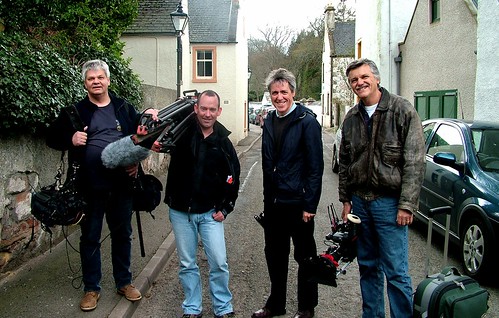The Photo they tried to Ban
The BBC TV series Restoration is featuring the Cromarty East Kirk in this years series. I snapped the crew - including presenter Griff Rhys Jones - as they walked past our house, back in early May. Posted it on Flickr, and on the Cromarty Image Library.
Then came a very polite note from the production company asking for it to be removed, as it would pre-empt this years marketing campaign for the Restoration programme.
Well the press release is out - its been featured on Reporting Scotland and the whole world seems to know. So I guess its safe to re-post the photo......
One final point, and this is where I turn into a seriously grumpy old man. The series is called Restoration Villages.... Sigh
Quick question to the Beed, the production team, and a large part of the UK population.
Which part of "Cromarty is not a Village , its a Town" do you not understand!!!!!
Here is a more rational explanation - posted back in January - on the whole town/village thing:-
"One final point - and perhaps a pedantic one (grin) but Cromarty - where I live - is a town not a village. I'll agree it's a very small town - only 600 souls in the town and 800 in the Parish, but has been a town for 1000 years, and a burgh for the past 800. In fact I can trace one branch of my family tree directly back to a John Urquhart who left Cromarty in 1410 to buy a farm in Orkney, when Cromarty was the second biggest town in the Highlands after Inverness.
Inverness is now a thousand times bigger than Cromarty....."

you wrote "a John Urquhart who left Cromarty in 1410 to buy a farm in Orkney"
What is the evidence (source) for the statement?
Posted by Anonymous |
4:42 PM
Anonymous |
4:42 PM
Susan Cromarty in New Zealand - who runs the Scots Heritage Magazine - and I are very distant cousins - and she kindly provided me with a copy of the complete Cromarty Family tree, in which I can trace one branch of the family back to a John Cromarty who purchased a farm in South Ronaldsay in the early 15th Century. This John Cromarty is the first time that the name Cromarty (as a family name)appears - anywhere - and pretty much any Cromarty in the world can trace themselves back to this chap. The Clan Cromarty website has this interesting piece:-
"There has been much speculation about the originations of the name. Our best understanding of this is provided by the noted Orcadian historian, J. Storer Clouston, who in the mid 1920s undertook an investigation of Orkney Headstones. Fortunately one of the families he chose to study was ‘Cromarty’. In a paper presented to the Orkney Antiquarian Society in 1928, Mr Clouston discusses three Cromarty headstones. Only one is dated – 1648 - but all are believed to be from the same period. All three stones show the three boars heads, which also appear on the Urquhart arms. Mr Clouston writes:
"Figs. 28, 29 & 30 are all Cromarty coats and they provide a good illustration of how much it is sometimes possible to learn from these old arms.
Fig. 28 is on the tombstone of Katherine Cromarty, spouse of Donald Polson, skipper, who died in 1648. It has her initials alone, and is another example of two coats conjoined per fess. Above are three boars heads and below, a stag, apparently 'at gaze'. i.e. with its head turned to face the spectator.
Fig. 29 has lost all trace of initials and inscription, but is obviously Cromarty also, and of about the same period. The arms are the same, except that the division line has been made too high so that there seems to be a 'chief' with the three heads on it; and that the stag is evidently 'springing' (although handicapped by the loss of both forelegs. I may add that it might be argued that in 28 the line is too low and should really mark a chief. It will be observed however that the necks have been made grotesquely long to fill the space which indicates that the division line is in its correct position and this is confirmed by the next coat.
Fig. 30 shows the arms on the tombstone of E.E. "ane honest woman", spouse of Thomas Cromarty in Hoxa. By a curious oversight her name has been omitted, but that the arms were not hers, but her husband's appears from the presence of his initials above. I kniow of no case where a husband belonging to a family who bore arms , put up his wife's arms only , with his own initials. As this entirely accords with the evidence of Fig. 28 we see that the Cromarty arms were three boards heads placed 2 and 1 (though rearranged in the conjoint shield."
Here we get a ray of light on the problem of who these Orkney Cromartys really were. Obviously they came from Cromarty, but the name is never found there; in fact it is only found in Orkney and (in the year 1500) in Caithness. We only know that they were a family of good position when they first appeared in the far north, who had evidently dropped their original surname and taken the name of the place whence they came. Now, the one family who reigned as lords and hereditary sheriffs of the then small district of Cromarty were the Urquharts of Cromarty, and their arms were three boars heads. That the Cromartys were originally Urquharts seems to follow as at least a highly probable inference."
Posted by Calum |
6:17 PM
Calum |
6:17 PM